¶ Introduction
This documentation presents an example of takeoff performance calculations for Boeing 737. It is called self-dispatch, primarily used by airline crew if that information cannot be obtained from the airline dispatch team. Performance data are usually taken from the Flight Crew Operations Manual (FCOM).
As we know, a Boeing 737 is a medium transport multi-engine jet able to ferry passengers and cargo on a high speed all over the world. It was manufactured, tested and certified to meet high safety standards required by aviation authorities. Regarding EU-OPS performance classification, the B737 is a Class A airplane (as any other multi-engine turbojet powered airplane). Class A airplanes must meet certification requirements described in EASA CS-25 and operational requirements described in EU-OPS1.
¶ Theory: operational requirements
Generally for takeoff performance calculations the following data need to be considered:
- Airplane weight.
- Available runway length and condition.
- Usable speeds.
¶ Airplane weight
Regulations define the list of limitations applied for the takeoff weight. We know that manufacturers define the maximum takeoff weight (MTOW) for airplanes, based on structural or other limits. On the other hand, there is another set of limitations applying to the allowed takeoff weight related to departure conditions.
So, the maximum allowed weight for takeoff is determined as a minimum of:
- Aerodrome distance available.
- Climb requirements.
- Obstacle clearance requirements.
- Tyre speed limitations.
- Brake energy limitations.
- Maximum certified weight.
This weight is called the performance limited weight. It is important to find out all limitations for a particular flight and apply the most stringent of them.
All the limits can be obtained from the FCOM as shown in the example below.
Never exceed maximum allowed weight. It could lead to unexpected airplane behaviour, performance limitations and structure damage.
¶ Runway length
The distance required for takeoff consists of two segments:
- The ground run from break release point (BRP) to lift off.
- The airborne distance to a defined height (also known as screen height).
The total distance from BRP to the screen height is called the takeoff distance (TOD).
In so far as a Boeing 737 classified as a Class A airplane, it was certified to meet safety standards and all applicable performance margins in particular situations. As a pilot you need to know, that performance data provided by Boeing guarantees the following:
- Screen height of 35 ft with both engines operating on a dry or wet runway.
- Screen height of 35 ft with one engine inoperative on a dry runway.
- Screen height of 15 ft achieved in a manner consistent with the achievement of V2 by 35 ft with one engine inoperative on a wet runway.
It is essential to every pilot to understand that there is a hypothetical chance that the calculated performance will not be achieved. With regard to this, aviation authorities always use a set of special regulations and requirements to provide additional safety margins to all performance data. It is called Gross and Net performance and is subject to separate discussion.
Generally takeoff performance calculations are all about defining the lowest weight limit for given conditions (runway length and condition, density altitude, speed limits, obstacles etc) so that airplanes can safely depart.
¶ Usable speeds
¶ Definitions and Balanced V1
There are several airplane speeds associated with takeoff performance. We go through some of them.
VMCG -- minimum speed to maintain directional control on the ground with one engine inoperative using only aerodynamic controls.
Basically aerodynamic controls means rudder. It must be deflected to counteract the adverse yaw after engine failure (could be a critical engine or both engines failure).
For airplanes fitted with engines that can be derated for takeoff, reduction of thrust will result in reduction in the amount of yaw effect. So, the amount of force required to counter that yaw can be generated at a lower speed. This results in VMCG reduction and the potential for reduction in V1.
VMCG must always be less than V1.
V1 -- maximum speed at which the pilot must take the first action in order to stop the aeroplane within the remaining Accelerate Stop Distance Available (ASDA). It is also the minimum speed following engine failure whereby the pilot is able to continue takeoff within the remaining TOD.
V1 must not exceed VR.
If the engine were to fail before V1, then the decision would be to abort the takeoff. The reason is because with only one engine operating there would be insufficient takeoff distance left to accelerate the aeroplane to the screen height. If the engine were to fail after V1, the decision is to continue the takeoff. The reason is because the aeroplane is travelling too fast to be able to stop within the remaining ASDA.
Therefore, V1 is the only speed which makes the Takeoff Distance Required (TODR) to be the same length as the Accelerate Stop Distance Required (ASDR). Any other V1 speed leads to increasing the total field required for a safe takeoff. You can easily check this effect on the graph.
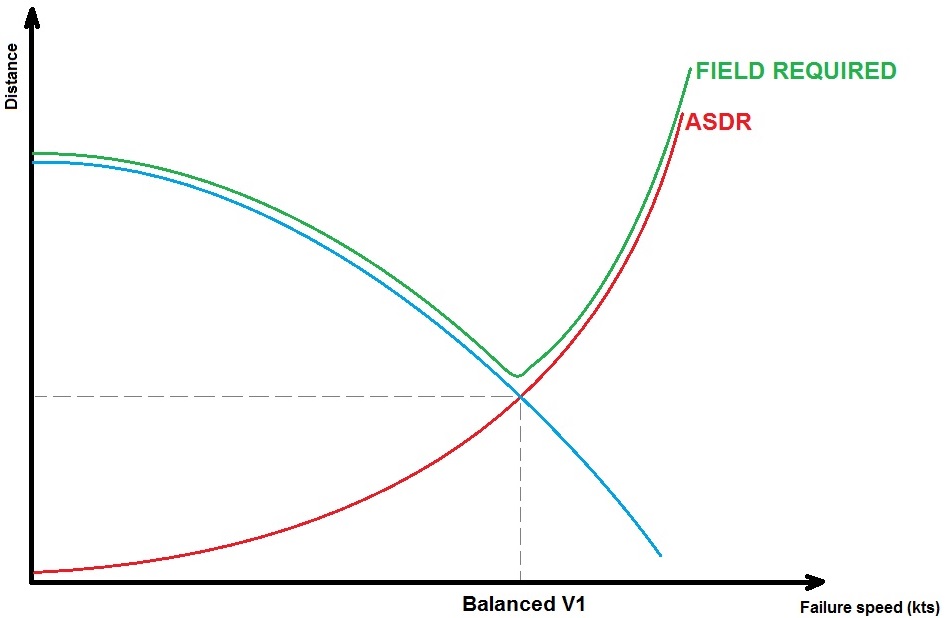
This concept is called "Idealized V1" or rather "Balanced V1". It comes from the balanced field concept, where the accelerated stop distance should be equal to the accelerated go distance. An aerodrome which has no stopway or clearway always has a balanced field.
VR -- rotation speed. This is the speed at which the pilot initiates action to raise the nose gear off the ground, with the intention of becoming airborne.
VR must not be less than V1.
VMBE -- maximum brake energy speed. It represents the maximum speed on the ground from which an aeroplane can safely stop within the energy capabilities of the brakes.
¶ Factors affecting V1
It is important to detail that factors can influence V1. Basically any factors change to the TODR or ASDR curves above will affect V1. However, the best way for understanding is to list those factors separately.
Every airplane flight manual, including Boeing 737 provides tables and/or graphs for V1 calculations on any given day. We will go through the example below.
1. Weight. Increasing weight increases V1.
2. Configuration. Increasing the flap angle decreases V1.
3. Field slope and wind. Downslopes reduce V1, upslopes increase V1. Tailwinds reduce V1, headwinds increase V1.
¶ Practical example
¶ Conditions and objectives
Conditions:
Airplane: Boeing 737-800 with winglets and 26K engine rating
MTOW: 79015 kg
TOW: 55000 kg.
Departure configuration: flaps 5, packs on, anti ice off
CG (%MAC): 18%
TORA: 2011 m.
TODA: 2111 m.
ASDA: 2211 m.
Runway condition: dry, 1% slope.
Obstacle: GSM antennas 60 m height on 3000 m from break release
Headwind component: 10 kts
Temperature +26o
Pressure altitude: 2000 ft.
Objectives:
1. Find takeoff distance available.
2. Find the lowest limiting takeoff weight.
3. Find takeoff speeds.
4. Find stab trim setting.
We need to use the Boeing 737 Flight Crew Operational Manual (FCOM), chapters Performance Dispatch and Performance Inflight. Make sure you are going to use correct data for certain airplane configuration, engine rating and aviation authority rules.
This documentation does not cover thrust management and engines thrust derate. This will be covered by a separate document. Full thrust takeoff is used for the current example.
Some of the airplanes manuals are multipurpose, do not mix up ICAO, EASA and FAA regulations and numbers; these can be different because of different certification regulations.
¶ Interpolation
Performance data provided in tables are always shown as round values to simplify the calculations. Pilots have two ways to deal with it: use the next higher number (Boeing officially states this) or simply the closest number to make quick calculations and optionally provide for extra margin. Sometimes it is also reasonable to interpolate between two near numbers.

where
X -- input variable ;
Xlow -- lowest value of two in table ;
Xhigh -- highest value of two in table ;
Flow -- lowest corresponding to X value in table ;
Fhigh -- highest corresponding to X value in table.
If this is not so clear, do not worry; several examples are present below.
Within this document we sometimes are going to use closest "worse" numbers to avoid long calculations.
¶ Performance limited weight calculation and runway length
¶ Line up alignment
Go to Performance Dispatch -- Text -- Takeoff
1. EUOPS-1 requires that the runway length be adjusted to account for alignment of the airplane prior to takeoff. Of course when an airplane is lining up it uses some field length. Boeing calculated these values for its 737. Let us assume we are going to line up on the runway with a 90 degree turn from the taxiway. Our runway length is 2011 m.

So, 2011 -- 11 = 2000 m.
Result: 2000 m of adjusted field length. Moving forward.
¶ Slope and Wind correction
Go to Performance Dispatch -- Takeoff -- Takeoff Field Corrections -- Dry Runway.
2. Correct known length for slope and wind components: find the actual field length in the left column, find the actual runway slope and find the value at the interception.
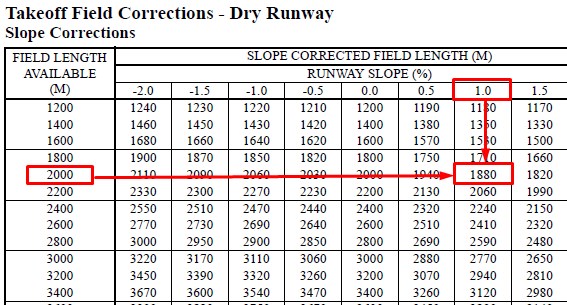
Result: 1880 m of slope corrected field length. We assume 1900 m. Moving forward.
3. At the next step enter for wind correction with the obtained slope corrected value. Our headwind component is 10 kts.
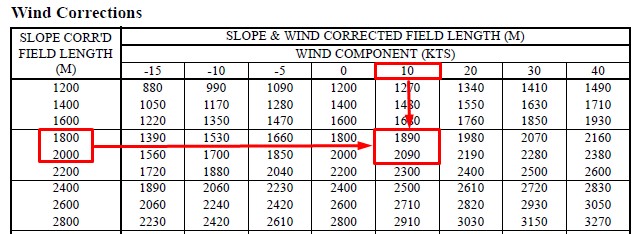
Here we can find an average of two near values (1900 m is the average of 1800 and 2000 m). Wind corrected field length = (1890+2090)/2 = 1990 m.
Result: 1990 m of wind and slope corrected field length.
¶ Field and Climb Limit weight
Go to Performance Dispatch -- Takeoff -- Takeoff Field & Climb Limit Weights - Dry Runway.
4. Now we are going to start calculating weight limitations. Enter the appropriate table for both field and climb limit weight. We need to use current pressure altitude, air temperature, airplane configuration and corrected field length. Remember our corrected field length is 1990 m and air temperature is +26oC, pressure altitude is 2000 ft. Find the appropriate table for 2000 ft pressure altitude and flaps 5 takeoff. Get the takeoff and climb limits from it (at the bottom).
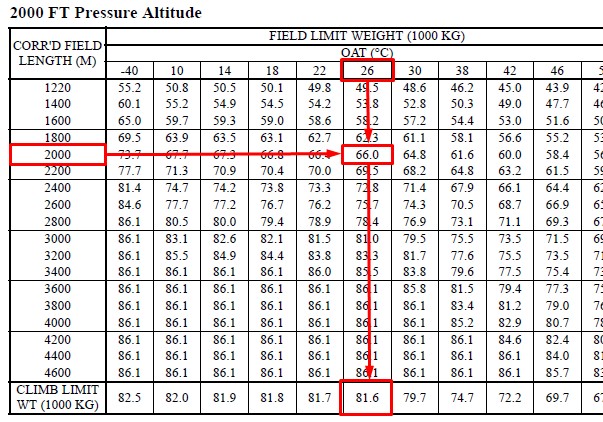
Our corrected field length is 1990 m, let us round it to 2000 m.
Do not forget to check additional corrections for packs and anti ice systems if applicable. Today we use packs for takeoff and do not use any anti ice.

Result: 66000 kg of field limit weight and 81600 kg of climb limit weight. Moving forward.
¶ Takeoff obstacle limit weight
Go to Performance Dispatch -- Takeoff -- Takeoff Obstacle Limit Weight.
5. Next we need to find the obstacle limit weight. Remember we have some GSM antennas on course within 3000 m of BRP and 60 m height. Use the appropriate table and then make all necessary adjustments. First we will find the basic obstacle limit weight for flaps 5 and then adjust it for temperature, pressure and wind.
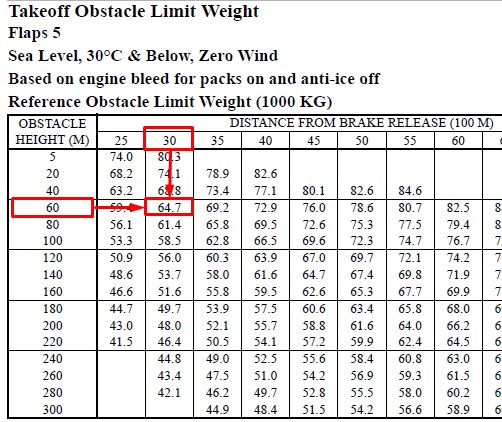
Result: 64700 kg is the basic obstacle limit weight.
6. The first adjustment is for temperature. Use the following table.

Result: No changes for temperatures of +26o. It remains 64700 kg.
7. The second adjustment is for pressure altitude. Remember it is 2000 ft today
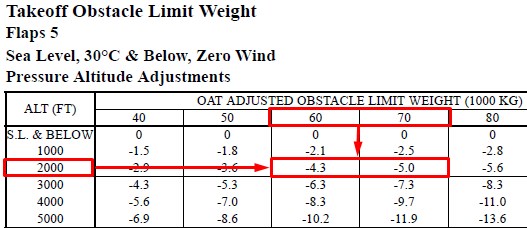
We need to interpolate the result between -4.3 and -5.0.

So, the adjusted value is 64700 -- 4600 = 60100 kg.
Result: 60100 kg. Moving forward.
8. Finally we need to adjust the obstacle limit weight for wind. Enter the next table with wind component and the previous result of weight.
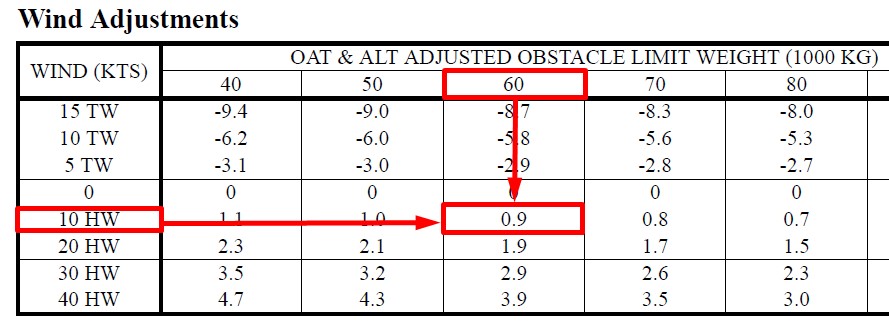
So, the adjusted value is 60100 + 900 = 61000 kg.
Do not forget to make further adjustments for packs and anti ice. Today we use packs for takeoff and do not use any anti ice.
Result: 61000 kg of obstacle limit weight.
¶ Tire speed limit weight
Go to Performance Dispatch -- Takeoff -- Tire Speed Limit Weight.
9. We should apply a couple of more calculations. The Tire Speed Limit Weight table allows to figure out the maximum tire speed limit weight. Make sure you are not going to destroy your tires during a high speed rejected takeoff. Enter the table with pressure altitude and air temperature.
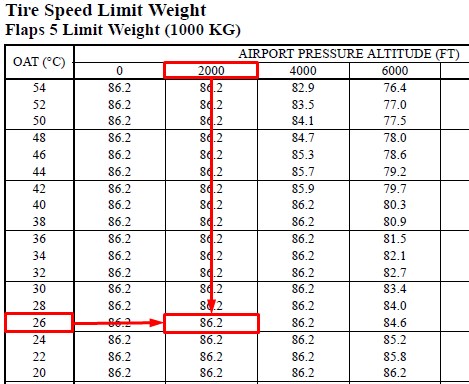
Result: 86200 kg of Tire Speed Limit Weight.
¶ Result on weight calculations
Let us compare all the results with respect to performance limited
weight and runway length calculations.
| Adjusted TORA | 2000 m |
| Corrected TORA | 1990 m |
| Field limit weight | 66000 kg |
| Climb limit weight | 81600 kg |
| Obstacle limit weight | 61000 kg |
| Tire speed limit weight | 86200 kg |
| MTOW | 79015 kg |
So, the most significant limitation is obstacle limit weight.
Takeoff distance available: 1990 m.
The lowest limiting takeoff weight: 61000 kg.
Current TOW is 55000 kg and it's 6 tonnes less than the limit.
¶ Takeoff speeds
At the next step we should calculate takeoff speeds.
Boeing states that FMC computed speeds can be used except special and abnormal situations (using of clearways or stopways, anti-skid inoperative etc. You can find the full list on Performance Inflight -- Text -- General chapter). That is why it is important to be able to use performance tables.
¶ Calculating V1, VR, V2 , VMCG
Go to Performance Inflight -- General - Takeoff Speeds - Dry Runway.
1. First, we need to calculate takeoff speeds. Enter the table with the current TOW. It is 55000 kg. Remember about flaps 5 takeoff.
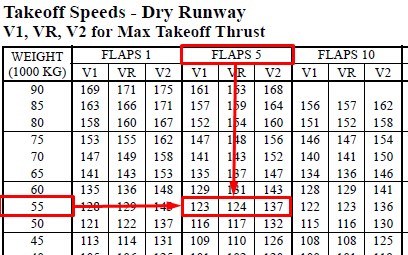
Result: V1 = 123 kts, VR=124 kts, V2 = 137 kts.
Go to Performance Inflight -- General -- V1, VR, V2 Adjustments
2. The next table is for temperature and pressure altitude adjustments.
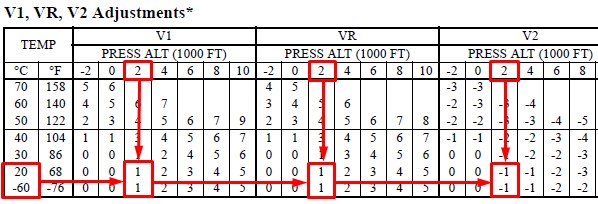
Result: V1 = 123 + 1 = 124 kts, VR = 124 + 1 = 125 kts, V2 = 137 -- 1 = 136 kts.
3. Finally we need to apply for slope and wind adjustments for V1.
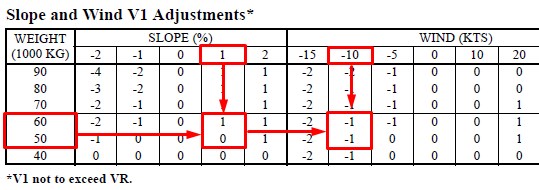
Since we should calculate average values because of 55000 kg TOW, we consider Slope gives us +1 and Wind gives -1. So no significant change in V1.
Result: V1 = 124 kts, VR=125 kts, V2 = 136 kts.
Go to Performance Inflight -- General -- V1 (MCG).
4. The next step is also significant, VMCG should be checked and compared to V1. As mentioned above, V1 always must be geater than VMCG.
If the calculated V1 is less than VMCG set V1 equal to initial value of V1
For additional information follow Performance Inflight -- Text -- General chapter of Boeing 737 FCOM.
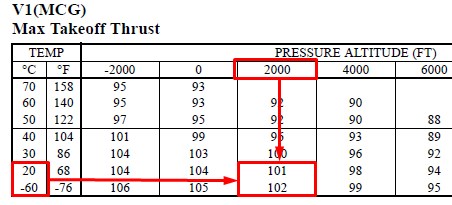
Result: VMCG is 101 kts, which is lower than V1 (124 kts).
¶ Clearway and stopway
Go to Performance Inflight -- General -- Maximum Allowable Clearway.
5. The next step is to deal with clearway and stopway. It directly affects V1. First we need to make sure that the existing clearway is allowed to use. Enter with corrected field length and remember our clearway is 100 m.
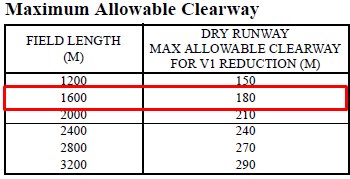
Result: Clearway of 100 m is inside the limit. Moving forward.
Remember that use of clearway is not allowed on wet runways.
Go to Performance Inflight -- General -- Clearway and Stopway V1 Adjustments.
6. The next step is to adjust V1 for clearway and stopway. In our example clearway and stopway subtraction gives us -100 m. Enter the table with current V1 and dry runway.
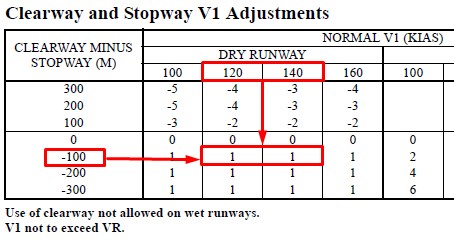
Adjusted V1 = 124 + 1 = 125 kts. If the adjusted V1 exceeds VR, reduce V1 to VR.
Result: V1 = 125 kts, VR=125 kts, V2 = 136 kts.
¶ Stab trim Setting
Go to Performance Inflight -- General -- Stab Trim Setting.
7. The last thing to be calculated before takeoff is the stabilizer trim setting. We need to know the centre of gravity (%MAC) to get this value.
CG (%MAC) is usually calculated on the weight and balance form/trim sheet. It is not covered by this document.
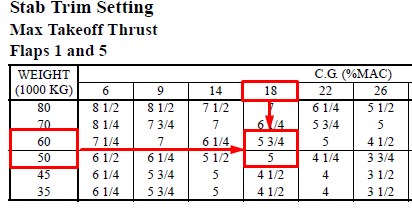
As before, interpolation is applied:

Result: Stab trim setting is 5.37.
¶ Example results
The airplane is going to depart with the following parameters:
TOW: 55000 kg
Performance limited weight: 58507 kg [Field limit weight]
V1 = 125 kts
VR= 125 kts
V2 = 136 kts.
Stab trim setting: 5.37
Remember that in some circumstances the performance limited landing weight could be applied and will limit the takeoff weight. Reading landing charts is covered by other documentation.
¶ Additional information
Pay additional attention that the B737 Flight Crew Training manual (FCTM) provides additional notes for takeoff speeds.
The FCOM and FMC computed takeoff speeds are only valid for performance, based on balanced field length. It does not consider runway length available, minimum engine-out climb gradient capability or obstacle clearance requirements. Compliance with all requirements should be verified separately with runway/airport analysis charts, another approved source or by dispatch.
- 737-800 Flight Crew Operational Manual by Boeing
- VID 531824 - Author
- VID 531824 - Wiki integration
- VID 200696 - Update
- VID 531824 - Update
- VID 496402 - Wiki.js integration